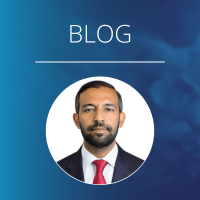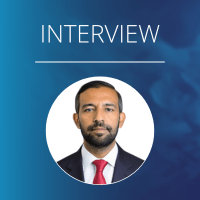Treasury in the Age of Fintech: Insights from Money 20/20
By Nirav Kanakia
The global representation in Las Vegas was remarkable – I connected with treasury professionals from Guam, Australia, India, Europe, and across the US, as well as several bankers from Japanese financial institutions who shared unique perspectives on digital transformation. My only regret was attending on short notice, which meant missing some exclusive side events. Next year, I’ll plan further ahead to maximize the experience!

What caught your attention the most at Money 20/20 this year? Any moments that stood out?
Nirav: What truly fascinated me was how the traditional roles seemed reversed at Money 20/20 this year. The bankers, who typically maintain a guarded approach in public forums, were surprisingly candid during their presentations – speaking freely about their AI strategies and operational challenges. Meanwhile, many fintech representatives adopted a more formal tone than I expected. It felt like watching a cultural exchange where East Coast button-up conservatism and West Coast innovative recklessness were borrowing elements from each other—perhaps signaling a healthier middle ground emerging in financial technology.
The global representation was remarkable – I connected with treasury professionals from Guam, Australia, India, Europe, and across the US, as well as several bankers from Japanese financial institutions who shared unique perspectives on digital transformation. My only regret was attending on short notice, which meant missing some exclusive side events. Next year, I’ll plan further ahead to maximize the experience!
Did you come across any fintech solutions that could make treasury work easier or more efficient?
Nirav: One clear takeaway from Money 20/20 was that corporate treasury represents a growing opportunity for fintech innovation. It often felt as though corporations—the actual end users of many financial services—were invisible in the conversation. Most presentations and solutions centered around consumer applications or banking infrastructure rather than addressing the specific challenges treasury professionals face daily.
Interestingly, I did have some meaningful conversations with stablecoin startups that actively sought me out. There was significant curiosity from stablecoin providers (I met with at least ten different ones) about the corporate treasury world and how their solutions could address our needs. They recognized that corporate treasury operations could benefit from blockchain-based solutions for cross-border payments, liquidity management, and settlement processes—suggesting that some innovators are beginning to see the untapped potential in serving corporate treasury functions.
Which new technologies or tools made you think, “This could change how companies handle payments or liquidity”?
Nirav: While specific treasury solutions were somewhat underrepresented, I observed three technological approaches that could revolutionize how companies manage payments and liquidity.
- First, the advances in AI-driven fraud detection and prevention stood out dramatically, with some institutions reporting 60-85% fraud reduction compared to traditional methods. For corporate treasurers managing substantial payment volumes, similar tools could significantly reduce fraud risk while improving straight-through processing rates.
- Second, Apple’s evolution of digital identity management could transform how we handle payment authorization and banking relationship management.
- Third, the integration of real-time payments with AI-powered liquidity forecasting tools shows enormous potential for more dynamic treasury management. What impressed me most was seeing these technologies moving beyond conceptual discussions to actual implementation at scale.
I also discovered a stealth-mode startup in the NY/NJ area deploying AI to deliver AI-powered lending solutions, which reminded me of my MUFG days and how we disbursed credit. Their approach could potentially transform how treasury departments access short-term funding and manage working capital. What struck me was how these truly innovative companies weren’t the ones with the flashiest booths or marketing—reinforcing the old wisdom that the best products often speak for themselves.
How did people at the event talk about AI in finance? Were there any approaches that seemed practical, not just hype?
Nirav: The conversation around AI at Money 20/20 has matured significantly. Financial executives discussed implementation with remarkable pragmatism, focusing on actual business problems rather than theoretical possibilities. Joanne Hannaford from Deutsche Bank made a point that resonated deeply: “The complexity of the problem should warrant AI.” This reflects a welcome shift from treating AI as a magical solution to being methodical about implementation.
The most practical approaches I observed were: using AI to augment human capabilities rather than replace them; focusing on data quality and governance as prerequisites for success; and measuring AI’s impact through concrete business outcomes rather than technical metrics. For treasury professionals, this suggests we should identify specific workflows where AI could add significant value—like cash forecasting or payment anomaly detection—while being realistic about data requirements and implementation challenges.
Did you notice any interesting collaborations between banks, fintechs, and corporates that could affect treasury operations?
Nirav: The collaboration landscape revealed how traditional competitive boundaries are dissolving. Major banks like Deutsche Bank are forming strategic partnerships with both technology giants like Microsoft and specialized fintechs to address specific pain points. These aren’t superficial marketing partnerships but deeply integrated technological collaborations.
Mastercard’s approach particularly caught my attention—they’ve built a comprehensive consultant program combining their payment expertise with Microsoft’s AI capabilities. For treasurers, such collaborations could deliver integrated solutions addressing the entire cash lifecycle. I also noted interesting partnerships around data governance and synthetic data generation, which could enable more powerful treasury analytics while maintaining compliance with privacy regulations.
What was missing, however, was direct corporate involvement in these partnerships—presenting an opportunity for treasury professionals to more actively engage with these ecosystems. I did come across an impressive startup founded by former Big bank executives that’s quietly bringing blockchain out of what the community calls “the graveyard of FUD” (Fear, Uncertainty, Doubt) by achieving 100K transactions per second. Their approach could finally make blockchain practical for high-volume treasury operations, but like many truly transformative innovators at the event, they preferred to remain in stealth mode. This reflected the intriguing East Coast/West Coast dynamic—where East Coast caution brings needed governance to West Coast technological boldness.
What’s one thing from the event that gave you a fresh idea or made you rethink how treasury could work?
Nirav: The most transformative insight came from the convergence of two trends: agentic AI in financial operations and the rapid rise of stablecoins. The agentic AI discussions made me reimagine treasury operations not as discrete processes, but as a continuous, dynamic system where AI agents handle routine activities while constantly adapting to changing conditions—fundamentally changing how we approach treasury work.
Equally eye-opening were discussions about stablecoins, where speakers highlighted that transaction volumes have already surpassed traditional payment networks in some markets. I discovered an Indian startup building quietly on stablecoin infrastructure that could potentially solve several persistent treasury challenges in cross-border payments. For corporate treasurers, this represents both opportunity and risk: stablecoins could dramatically reduce settlement times and costs for cross-border payments, but as every institution rushes to create their own stablecoins, we face potential fragmentation that could increase complexity.
What struck me was the regulatory divergence between regions—the US embracing stablecoins through legislation like the GENIUS Act, while European discussions remain more CBDC-focused. This vision of treasury’s future—combining agentic AI with blockchain-based payment infrastructure—suggests our role will shift dramatically from transaction execution to strategic oversight. The tension between East Coast regulatory prudence and West Coast technological ambition will ultimately determine how quickly and effectively this transition happens for corporate treasury functions.
Can’t get enough? Check out these latest items
 https://treasuryxl.com/wp-content/uploads/2025/06/Nirav-Interview-1.png
200
200
treasuryXL
https://treasuryxl.com/wp-content/uploads/2018/07/treasuryXL-logo-300x56.png
treasuryXL2025-11-04 07:00:482025-11-04 16:19:30Treasury in the Age of Fintech: Insights from Money 20/20
https://treasuryxl.com/wp-content/uploads/2025/06/Nirav-Interview-1.png
200
200
treasuryXL
https://treasuryxl.com/wp-content/uploads/2018/07/treasuryXL-logo-300x56.png
treasuryXL2025-11-04 07:00:482025-11-04 16:19:30Treasury in the Age of Fintech: Insights from Money 20/20 https://treasuryxl.com/wp-content/uploads/2025/06/Nirav-Interview-1.png
200
200
treasuryXL
https://treasuryxl.com/wp-content/uploads/2018/07/treasuryXL-logo-300x56.png
treasuryXL2025-07-30 08:41:272025-07-30 08:41:27GENIUS Act Signed – Stablecoins Get Clarity! (pun intended)
https://treasuryxl.com/wp-content/uploads/2025/06/Nirav-Interview-1.png
200
200
treasuryXL
https://treasuryxl.com/wp-content/uploads/2018/07/treasuryXL-logo-300x56.png
treasuryXL2025-07-30 08:41:272025-07-30 08:41:27GENIUS Act Signed – Stablecoins Get Clarity! (pun intended) https://treasuryxl.com/wp-content/uploads/2025/06/Nirav-Interview-1.png
200
200
treasuryXL
https://treasuryxl.com/wp-content/uploads/2018/07/treasuryXL-logo-300x56.png
treasuryXL2025-07-23 07:00:062025-07-22 10:00:54AI vs. Stablecoins: Treasurers’ Surprising (is it) Verdict
https://treasuryxl.com/wp-content/uploads/2025/06/Nirav-Interview-1.png
200
200
treasuryXL
https://treasuryxl.com/wp-content/uploads/2018/07/treasuryXL-logo-300x56.png
treasuryXL2025-07-23 07:00:062025-07-22 10:00:54AI vs. Stablecoins: Treasurers’ Surprising (is it) Verdict https://treasuryxl.com/wp-content/uploads/2025/06/Nirav-Interview-1.png
200
200
treasuryXL
https://treasuryxl.com/wp-content/uploads/2018/07/treasuryXL-logo-300x56.png
treasuryXL2025-06-24 07:00:242025-06-23 10:59:38In House Bank – Your Money Works For You Under Your Watch
https://treasuryxl.com/wp-content/uploads/2025/06/Nirav-Interview-1.png
200
200
treasuryXL
https://treasuryxl.com/wp-content/uploads/2018/07/treasuryXL-logo-300x56.png
treasuryXL2025-06-24 07:00:242025-06-23 10:59:38In House Bank – Your Money Works For You Under Your Watch https://treasuryxl.com/wp-content/uploads/2025/06/Nirav-Interview-1.png
200
200
treasuryXL
https://treasuryxl.com/wp-content/uploads/2018/07/treasuryXL-logo-300x56.png
treasuryXL2025-06-10 07:00:552025-06-10 09:06:37Banking Without Bankers: The AI Bank – 2030
https://treasuryxl.com/wp-content/uploads/2025/06/Nirav-Interview-1.png
200
200
treasuryXL
https://treasuryxl.com/wp-content/uploads/2018/07/treasuryXL-logo-300x56.png
treasuryXL2025-06-10 07:00:552025-06-10 09:06:37Banking Without Bankers: The AI Bank – 2030 https://treasuryxl.com/wp-content/uploads/2025/05/Nirav-Interview.png
200
200
treasuryXL
https://treasuryxl.com/wp-content/uploads/2018/07/treasuryXL-logo-300x56.png
treasuryXL2025-05-06 07:00:342025-05-22 13:05:58Interview | Still Coding, Still Curious: Nirav’s Journey into Fintech and Treasury Tech
https://treasuryxl.com/wp-content/uploads/2025/05/Nirav-Interview.png
200
200
treasuryXL
https://treasuryxl.com/wp-content/uploads/2018/07/treasuryXL-logo-300x56.png
treasuryXL2025-05-06 07:00:342025-05-22 13:05:58Interview | Still Coding, Still Curious: Nirav’s Journey into Fintech and Treasury Tech


